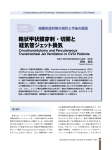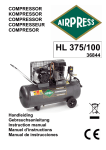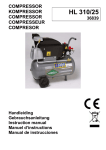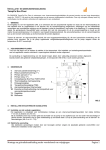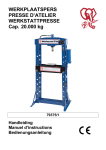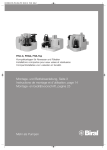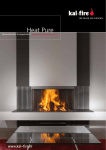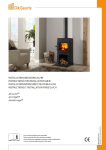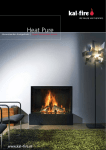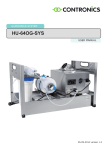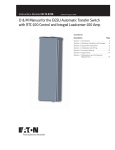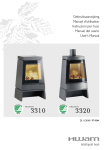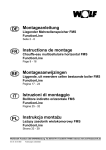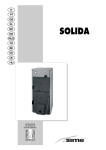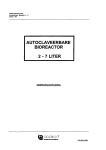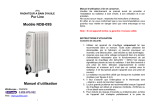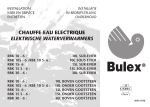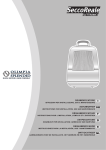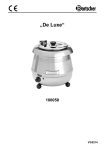Download Untitled - Krulalltech
Transcript
VOORWOORD ............................................................ 2 1. INLEIDING .......................................................... 2 2. EC CONFORMITEITSVERKLARING STORE ..... 2 3. VEILIGHEID......................................................... 3 3.1 Algemeen............................................................. 3 3.2 Voorschriften........................................................ 3 3.3 Voorzorgsmaatregelen / veiligheidsinstructies bij installatie ................................................................3 3.4 Aanvullende veiligheidsvoorschriften voor haards met cv wisselaar .................................................. 3 3.5 Noodzakelijke veiligheden nader toegelicht ........... 3 3.5.1 Thermische veiligheidsklep ................................... 3 3.5.2 Het overdrukventiel .............................................. 4 3.5.3 Ontluchting .......................................................... 4 UITPAKKEN .................................................................. 5 5. INSTALLATIE ...................................................... 5 5.1 Voorschriften........................................................ 5 5.2 Rookgaskanaal ..................................................... 5 5.3 Voorzieningen plaatsing haard .............................. 5 5.4 Plaatsen haard ..................................................... 5 5.5 Aansluiten haard .................................................. 5 6. STOKEN.............................................................. 6 7. OPLEVERING ..................................................... 6 8. ONDERHOUD ..................................................... 6 9. STORINGEN ....................................................... 6 Bijlage 1 Meegeleverde onderdelen ............................... 6 Bijlage 2 aansluitingen haard + lijntekening .................... 7 Bijlage 3 meegeleverde beveiligingen ............................ 8 Bijlage 4 Formulier voor oplevering Store H2O .............. 9 Bijlage 5 Installatieschema........................................... 10 Dik Geurts 1 N e d e r l a n d s INHOUD.......................................................................... 1 van de minimale eisen van rendement en emissieniveaus van verontreinigende stoffen voor verwarmingsapparaten voor vaste brandstoffen. VOORWOORD Als fabrikant van haarden ontwikkelt en produceert Dik Geurts producten volgens de hoogst mogelijke kwaliteits-, prestatieen veiligheidseisen. U kunt hierdoor rekenen op jarenlang gebruiksplezier. Deze haard is voorzien van een CE merk. Houtgestookte haarden die voldoen aan de essentiële eisen uit de Europese Bouwproductenrichtlijn, waaronder eisen voor veiligheid, milieu en energiegebruik, hebben het recht het CE merk te dragen. Bij de haard worden twee handleidingen geleverd: de installatiehandleiding en de gebruikershandleiding. De gebruikershandleiding geeft u de informatie die u nodig heeft om de haard goed en veilig te laten functioneren. Lees de gebruikershandleiding zorgvuldig alvorens de haard in gebruik te nemen. U dient de gebruikershandleiding én de installatiehandleiding zorgvuldig te bewaren. Als gebruiker mag u uitsluitend de werkzaamheden uitvoeren die in de gebruikershandleiding worden genoemd. Voor de overige werkzaamheden schakelt u een vakbekwame installateur in. De installatiehandleiding geeft u de informatie die u nodig heeft om de haard zo te installeren dat deze goed en veilig functioneert. Deze handleiding schenkt aandacht aan de installatie van de haard en de daarbij geldende voorschriften. Daarnaast treft u technische gegevens van de haard aan. Neem bij vragen of twijfel altijd contact op met uw installateur. U dient deze installatiehandleiding zorgvuldig te lezen en te gebruiken. In de handleidingen worden de volgende markeringen gebruikt om belangrijke informatie aan te geven: ● ! Let op Product: Vrijstaande, houtgestookte boiler gemaakt van plaatstaal. Type: Store Van toepassing zijnde EC-richtlijnen: 89/106/EEC Toegepaste geharmoniseerde normen: NEN/EN-13240 NEN/EN-13240/A2 Notified body: S.G.S. Nederland B.V. Leemansweg 51 Postbus 5252 6827 BX Arnhem Kenmerkende producteigenschappen TABEL zie bestaande handleiding Store Uit te voeren acties Deze instructies zijn noodzakelijk ter voorkoming van brand, persoonlijk letsel of andere ernstige schades. Na oplevering dient u de gebruikershandleiding én deze installatiehandleiding te overhandigen aan de gebruiker. 1. INLEIDING Gefeliciteerd met de aankoop van uw Dik Geurts haard. De vrijstaande houtgestookte haard heeft een uitgekiend stooksysteem dat zorgt voor een effectieve verbranding en een optimaal rendement. De verbrandingsruimte is bekleed met vuurvaste platen. Bovenin ligt een zogenaamde keerplaat om het rendement te verhogen. De haard is uitgerust met een schuif voor de luchttoevoer, een deel van de secundaire lucht wordt continu langs de bovenkant van de ruit geleid. De haard is uitsluitend geschikt om gestookt te worden met hout of houtbriketten. Brandstof Hout Werking Intermitterend Afstand tot brandbare materialen 700 mm Emissie van CO: 0,09 vol.% bij 13% verbrandingsproducten O2 Rookgastemperatuur 266 °C Nom. direct vermogen 3,9 kW Nom. waterzijdig vermogen 6,5 kW Rendement 76,1 % Rookgasstroom 10,6 g/s Fijnstof bij 13% O2 [mg/Nm3] 33 Diameter uitgang 180 mm Brandveiligheid voldoet Vrijkomen van schadelijke stoffen geen Oppervlaktetemperatuur voldoet Mechanische sterkte voldoet Gewicht haard 270 kg Minimale schoorsteentrek 12 Pa Waterinhoud 25 liter Geschikt voor een gedeeld Nee schoorsteenkanaal 2. EC CONFORMITEITSVERKLARING STORE Rapport EZKA/11/053-Z De ondergetekende, vertegenwoordiger van: Door bedrijfsinterne maatregelen is gewaarborgd dat seriematig geproduceerde toestellen aan de essentiële eisen van de van kracht zijnde EC-richtlijnen en de daarvan afgeleide normen voldoen. Deze verklaring verliest haar geldigheid als zonder schriftelijke toestemming van DRU Verwarming B.V. wijzigingen aan het toestel worden aangebracht. Fabrikant: DRU Verwarming B.V. Postbus 1021, NL-6920 BA Duiven Ratio 8, NL-6921 RW Duiven Verklaart hiermee dat het door DRU uitgebrachte houtgestookte verwarmingstoestel door zijn ontwerp en bouwwijze voldoet aan de essentiële eisen van de Bouwproductenrichtlijn en dat ze geproduceerd en verdeeld wordt volgens de eisen van het koninklijk besluit van 12 oktober 2010 tot regeling Namens DRU Verwarming B.V. M.J.M. Gelten Algemeen directeur 2 3.1 Algemeen Het veilig installeren van een Dik Geurts haard met warmtewisselaar voor vaste brandstoffen vereist specialistische vakkennis. Deze installatiehandleiding vormt een essentieel onderdeel in de installatie- en bedieningsinstructie voor dit type haarden. Lees deze handleiding daarom zorgvuldig door en volgt de instructies nauwgezet op! In paragraaf 3.4 worden aanvullende veiligheidsvoorschriften vermeld, specifiek voor dit type toestellen. In bijlage 4 is een checklist opgenomen, die u helpt het toestel veilig te installeren. ! Controleer of deze, voor de installatie noodzakelijke, veiligheden aanwezig zijn en begin pas daarna met de installatie! ● Let op ● Leest u dit hoofdstuk over veiligheid zorgvuldig door voordat u begint met installatie of onderhoud; Houdt u zich aan de algemeen geldende voorschriften en de voorzorgsmaatregelen/veiligheidsinstructies in deze handleiding. ● ● Het in bedrijf nemen van de haard zonder de zekerheid, dat alle veiligheidscomponenten optimaal geïnstalleerd zijn, is niet toegestaan. Zorg voor een goede voorziening voor ontluchting van de warmtewisselaar. 3/8”. Alle veiligheidscomponenten moeten na installatie goed bereikbaar zijn voor controle- en servicedoeleinden. Alle gebruikte componenten voor de waterzijdige installatie moeten minimaal bestendig zijn tegen temperaturen van 110 °C. Alle geïnstalleerde componenten, die geen deel uitmaken van de levering door Dik Geurts, moeten aanwijsbaar geschikt zijn voor toepassing in cv systemen. Bij de eerste ingebruikname van de haard dienen alle stappen van de bedieningshandleiding te worden gerespecteerd. De gebruiker dient duidelijk geïnstrueerd te worden over de werking en het onderhoud van de installatie. Adviseer de gebruiker jaarlijks een afspraak te maken voor controle en onderhoud. De elektrische aansluiting dient volgens de plaatselijk geldende norm te worden te worden gerealiseerd. ● ● ● 3.2 Voorschriften Installeer het toestel volgens de geldende Europese, nationale, lokale en bouwkundige (installatie)voorschriften. Voor Nederland geldt onder meer het Bouwbesluit. ● ● 3.3 ● ● ● ● ● ● ● ● ● ● ● ● ● Voorzorgsmaatregelen / veiligheidsinstructies bij installatie installeer en onderhoud de haard alleen als u een vakbekwame installateur op het gebied van houtgestookte CV toestellen bent; plaats de haard op een vloer met voldoende draagkracht; plaats de haard en/of de haardpijpen voor een wand van niet brandbaar materiaal; breng indien u brandbare materialen aantreft voldoende niet brandbaar isolatie materiaal aan; plaats de haard en/of de haardpijpen op minimaal 50 mm vanaf de niet brandbare wand; plaats de haard en/of de haardpijpen altijd op minimaal 700 mm afstand van brandbare objecten en/of materialen; plaats de haard op een beschermende vloerplaat in geval van een brandbare vloer. De vloerplaat van niet brandbaar materiaal dient minimaal 300mm voor de haard uit te steken en een minimaal 300 mm breder te zijn dan de haard; dek de haard niet af en/of pak deze niet in met een isolatiedeken of enig ander materiaal; sluit de haard aan op een geschikt rookgaskanaal; laat het rookgaskanaal vooraf inspecteren en reinigen door een erkend schoorsteenveegbedrijf; breng zelf geen wijzigingen aan de haard aan; gebruik uitsluitend originele onderdelen ter vervanging; zorg voor voldoende ventilatie in de opstellingsruimte. 3.4 ! ● ● ! Let op Wanneer de installatie niet aan deze punten voldoet, vervalt elke vorm van productgarantie. 3.5 Noodzakelijke veiligheden nader toegelicht 3.5.1 Thermische veiligheidsklep Het toestel wordt volgens de norm EN 12828 beveiligd tegen een te hoge watertemperatuur. Hiertoe is een thermische veiligheidsklep meegeleverd. ! Let op De thermische veiligheidsklep dient op een ‘koele’ plaats (< 50 °C) te worden gemonteerd en altijd goed toegankelijk te zijn. ! Aanvullende veiligheidsvoorschriften voor haarden met cv wisselaar Let op Een minimale waterdruk van 2.0 bar moet gegarandeerd zijn. Wanneer de waterdruk niet gegarandeerd is, mag installatie alleen plaatsvinden op een open expansiesysteem. De veiligheidsklep is uitgevoerd met een zeer dunne en kwetsbare capillaire leiding. Deze heeft als functie de druk, die opgebouwd wordt in de voeler, over te brengen naar de klep. Let op Bij de installatie van een Dik Geurts haard met cv wisselaar zijn de volgende zaken essentieel: ● Installatie zonder de meegeleverde veiligheden is niet toegestaan. Dik Geurts 3 N e d e r l a n d s Een haard van Dik Geurts wordt altijd geleverd met de onderstaande veiligheden: - Veiligheidswarmtewisselaar (in het toestel geïnstalleerd); - Thermische veiligheidsklep, met vloeistofgevulde voeler en capillaire leiding; - Overdrukventiel, 3 bar 3. VEILIGHEID Hieronder volgen tips en instructies die belangrijk zijn voor de goede werking van uw haard. De leiding van het overdrukventiel naar de afvoer moet aan bepaalde eisen te voldoen. Bij een leiding met een maximale lengte van 2 meter: - het maximale aantal bochten in deze leiding is 2; - de minimale diameter van deze leiding is ½”; - deze moet vrij van afsluiters en weerstanden zijn. Wanneer de klep door beschadiging lekt, is de werking niet meer gegarandeerd en dient de klep te worden vervangen. !Let op De capillaire leiding van de thermische veiligheidsklep mag nooit geknikt, ingekort of beschadigd worden. ! Let op Bij - De uitmonding van de overstortleiding dient op een veilige plaats te worden gemonteerd. De uitmonding van de overstortleiding moet zo worden gemonteerd, dat er geen gevaar voor de gebruiker kan ontstaan. Bij het in werking treden van deze veiligheid, stroomt water van ongeveer 100 °C uit de afvoerleiding. een leiding met een maximale lengte van 4 meter: het maximale aantal bochten in deze leiding is 3; de diameter van deze leiding is ¾”; deze moet vrij van afsluiters en weerstanden zijn. ! Let op Indien dit ventiel vervangen moet worden, dient een klep met exact dezelfde specificaties te worden gemonteerd. Het aansluiten van een thermische veiligheidsklep is schematisch weergegeven in bijlage 4. ! ! Let op Monteer de afblaasleiding van het overdrukventiel buiten het directe bereik van personen. Het overdrukventiel dient op een toegankelijke plek te worden gemonteerd voor periodieke tests. Zorg ervoor dat de uitmonding van de afvoerleiding van de thermische veiligheidsklep op doorstroming en lekkage te controleren is. ! 3.5.3 Ontluchting Een goede ontluchting is van groot belang voor de werking van het systeem. Ga voor een goede ontluchting als volgt te werk: - aan de achterzijde van het toestel bevindt zich een 3/8” binnendraad sok; - monteer hier een ontluchtinrichting; - voorzie het systeem in de aanvoer en retour van ontluchtmogelijkheden. Let op De aansluitleiding voor de thermische veiligheidsklep moet vorstvrij worden aangelegd. Bevriezing moet te allen tijde worden voorkomen. 3.5.1.2 De werking van de thermische veiligheidsklep. De thermische veiligheidsklep is een op koud leidingwater werkende veiligheid. Wanneer de temperatuur aan de voeler van de klep te hoog wordt, opent de klep. In dat geval wordt koud leidingwater door de koelspiraal gestuurd om de overtollige warmte af te voeren. Vermenging van leidingwater en water uit het verwarmingssysteem is hierbij uitgesloten, omdat de koelspiraal gescheiden is van de ketel. De veiligheidsklep opent bij 95 °C (+/-3 °C) en zorgt ervoor, dat de keteltemperatuur onder de 110 °C blijft. ! Let op Wanneer lucht zich ophoopt in het systeem, kan de pomp het cv water niet goed transporteren. De temperatuurbeveiliging kan dan, vanwege te hoge temperaturen, in werking treden, voordat het toestel warm water aan het systeem afgeeft. 3.5.4 Droogkookbeveiliging 3.5.2 Het overdrukventiel Een te hoog oplopende druk in het systeem is schadelijk. Om dit te voorkomen, is bij het toestel een overdrukventiel meegeleverd. ! Let op ! Let op In een half met water gevulde haard, kan zich stoom vormen, wat tot gevaarlijke situaties kan leiden. Dit is het geval wanneer radiatoren, buffervaten of andere, met water gevulde, elementen binnen het systeem, zich onder het niveau van de haard bevinden. Plaats ter voorkoming een beveiliging, die het waterniveau controleert. Let op Het overdrukventiel moet altijd worden geïnstalleerd! Zonder deze klep kan een veilige werking van het systeem niet worden gegarandeerd. Houd voor een veilige en correcte werking van het overdrukventiel rekening met het volgende: - sluit het overdrukventiel aan op de haard; - gebruik hiervoor een leiding met een minimale diameter van ½”; - afsluiters en weerstanden in de leiding zijn niet toegestaan; - gebruik maximaal één bocht. 4 UITPAKKEN 5.4 Schenk aandacht aan de onderstaande punten bij het uitpakken van de haard: ● Controleer het toestel op transportschade, plaats nooit een beschadigde haard; ● Controleer of de doos met onderdelen compleet is. ● In Bijlage 1 / Tabel 1 staat vermeld over welke onderdelen u na het uitpakken dient te beschikken; ● Door het transport kunnen onderdelen verschoven zijn, controleer de ligging van de keerplaat en vuurvaste platen. (zie handleiding). ● Controleer de werking van luchtschuif, deursluiting en het eventuele draaimechanisme; ● Verwijder eventueel achtergebleven straalgrit uit de luchtschuif; ● Neem zo nodig contact op met uw leverancier; ● Voer de verpakking af via de reguliere weg. ! ● ● ● ● ● ● ● ● 5. INSTALLATIE ● 5.1 ● ● Voorschriften Installeer de haard volgens de geldende Europese, nationale, lokale en bouwkundige (installatie) voorschriften. Houdt u zich aan de voorschriften/instructies zoals vermeld in deze handleiding. ● ● ● ● ● 5.2 ● ● ● ● ● ● ● ● ● ● ● Plaatsen haard ● Rookgaskanaal Voor het rookgaskanaal gelden de volgende eisen: het rookgaskanaal moet van tevoren geïnspecteerd worden door een specialist; het rookgaskanaal dient geschikt te zijn voor aansluiting van een houtgestookt toestel; de haard dient te worden aangesloten op een enkel, ongedeeld rookgaskanaal; het rookgaskanaal moet schoon zijn; het rookgaskanaal moet gasdicht zijn; de diameter van het rookgaskanaal moet 180 mm zijn; de trek van het rookgaskanaal moet minimaal 12 Pascal zijn; in een (te) sterk trekkend kanaal dient zonodig een rookgasklep worden aangebracht; haardpijpen moeten afwaterend naar de haard worden geplaatst; het rookgaskanaal dient zelfdragend te zijn en mag niet op de haard rusten; Let op Breng geen wijzigingen aan de haard aan; plaats de haard op een vloer met voldoende draagkracht; plaats de haard en/of de haardpijpen tegen een wand van niet brandbaar materiaal; plaats de haard en/of de haardpijpen op minimaal 50 mm vanaf de wand; plaats de haard en/of de haardpijpen altijd op minimaal 700 mm afstand van brandbare objecten en/of materialen; plaats de haard op een brandwerende vloerplaat die volgens de geldende norm voor de haard uitsteekt als deze op een vloer van brandbaar materiaal komt te staan; dek de haard niet af en/of pak deze niet in met een isolatiedeken of enig ander materiaal; houdt u zich aan de eisen voor het rookgaskanaal zoals genoemd in paragraaf 5.2. Bepaal de plaats van de haard; de afmetingen zijn aangegeven in bijlage 2. Plaats zo nodig de vloerplaat. Zet de haard op de bestemde plek. Controleer of de vuurvaste platen en de keerplaten in de haard goed geplaatst zijn (zie gebruikshandleiding). Verbeter zo nodig de positie van de platen. Sluit de haard aan op het rookgaskanaal. Plaats een optioneel verkrijgbaar inspectie-element, indien de afvoerpijp niet verwijderd kan worden bij onderhoud aan de kachel. In dit halve meter afvoerelement zit een inspectieluikje om het eventuele roet te verwijderen wat bovenop de stalen keerplaat in de kachel ligt. 5.5 Aansluiten haard Ga bij het aansluiten van de haard als volgt te werk (voor een tekening van de aansluitingen zie bijlage 2): ● sluit de thermische veiligheidsklep (bijlage 3 figuur 1) aan op de aanvoer (D) van de koelspiraal. Zorg dat de pijl op de veiligheidsklep richting de aansluiting van de koelspiraal wijst (zie bijlage 2). ● sluit de afvoer van de koelspiraal (E) aan op de waterafvoer of riolering; ● plaats de dompelhuls voor de voeler (figuur 3) van de thermische veiligheidsklep in de watermantel. Dit is de sok links boven op de achterkant van de haard. ● schuif de voeler van de thermische veiligheidsklep (A) in de zojuist aangebrachte dompelhuls. Borg de voeler met de schroef die in de dompelhuls zit (figuur 3). ● sluit de retour van het te verwarmen CV-water aan op de 3/4’’ sok; deze bevindt zich aan de onderzijde van de watermantel (zie bijlage 2) (G). ● sluit de aanvoer van het verwarmde CV-water aan op de één van de aanvoeraansluitingen (3/4’’ sok). (zie bijlage 2) 5.3 Voorzieningen plaatsen haard Voor het plaatsen van een vrijstaande haard met directe warmte èn warm water als output, dienen de volgende voorzieningen, op de plaats van de haard, aanwezig te zijn: ● een waterleidingaansluiting ten behoeve van de veiligheidswarmtewisselaar; ● een aansluiting op de waterafvoer of riolering ten behoeve van de veiligheidswarmtewisselaar en het overdrukventiel. ● Let op: Houd rekening met een temperatuur van 100 °C in het afvoersysteem. ● een aanvoer en retour van het cv-systeem; ● een mogelijke elektriciteitsaansluiting bij gebruik van de pomp (deze pomp is een essentieel onderdeel van het systeem, maar wordt niet meegeleverd!). Er zijn twee aanvoeraansluitmogelijkheden: aanvoer 1 (C) zit bovenin de watermantel en aanvoer 2 (F) zit onderaan de watermantel. Deze laatste aanvoer haalt het warme water uit de bovenkant van de watermantel door middel van een buis die door de watermantel loopt. Het aanvoerwater van aanvoer 2 is daardoor minder heet dan het water uit aanvoer 1. Afhankelijk van de retourtemperatuur is de maximale temperatuur die uit aanvoer 2 gehaald kan worden 80 °C. Dik Geurts 5 N e d e r l a n d s 4. ● ● Voor maximale prestatie wordt geadviseerd aanvoer 1 te gebruiken. Als de hoge aanvoertemperatuur niet nodig is, kan aanvoer 2 gebruikt worden zodat alle leidingen onder aan de haard zitten. plaats het overdrukventiel (figuur 4) in de afvoer CV-leiding van de haard en sluit deze aan op de waterafvoer of riolering (zie ook hoofdstuk 3.5.2). ! ● 8. ONDERHOUD In de Gebruikershandleiding wordt in Hoofdstuk 6, Onderhoud, een aantal tips/instructies gegeven voor het onderhoud van de haard. Tevens is vermeld hoe een aantal onderdelen vervangen kan worden. Let op 9. STORINGEN In de Gebruikershandleiding, hoofdstuk 7, staat een tabel met een overzicht van storingen die kunnen optreden, de mogelijke oorzaak en de oplossing. Tussen het overdrukventiel en de haard mogen geen afsluiter of andere weerstanden geplaatst zijn! Bijlage 1 Meegeleverde onderdelen In de onderstaande tabel staan de onderdelen vermeld die met het toestel worden meegeleverd. 5.6. Retourtemperatuurbewaking. Om te voorkomen dat de warmtewisselaar te veel vervuild is het belangrijk de haard zo snel mogelijk boven de condensatietemperatuur van de rookgassen te brengen en te houden. Dit dient te gebeuren doormiddel van een retourtemperatuurbewaking welke ervoor zorgt dat de retourtemperatuur naar de haard niet onder de 60˚C komt. Een dergelijke unit is bij Dik Geurts te bestellen onder bestelnr. 45256.Het toepassen van een dergelijk systeem is verplicht om de goede werking van dit product te garanderen. In bijlage 5 is een voorbeeld installatieschema afgebeeld. Tabel 1: De verschillende componenten in dit schema zijn: a) Retourtemperatuurbewaking(pompunit). b) Expansievat. c) Ontluchter. d) Overdrukventiel(3bar) e) Thermisch laadventiel. f) Watertoevoer. g) Circulatiepomp cv-systeem. 6. STOKEN ! ● ● Wijs de gebruiker op de noodzaak de warmtewisselaar te reinigen (zie de gebruikershandleiding, hoofdstuk 2.1). Let op Een Dik Geurts haard met CV wisselaar mag nooit zonder water worden gestookt! Deze toestellen moeten eerst met water gevuld en ontlucht worden en mogen pas in gebruik genomen worden als de functionele installatie volledig afgerond is. Zie de Gebruikershandleiding, hoofdstuk 5, voor het aansteken en stoken van de haard. 7. OPLEVERING U dient de gebruiker vertrouwd te maken met de haard. U dient haar/hem te instrueren over onder meer de ingebruikname, het stoken en het onderhoud. ● Instrueer de gebruiker over de haard. ● Wijs er bij ingebruikname op, dat ● bij de eerste keer stoken vluchtige componenten uitdampen uit lak, materialen e.d.; ● de ruimte goed wordt geventileerd. ● Wijs op de noodzaak om het rookgaskanaal minstens één keer per jaar te laten inspecteren en reinigen door een specialist. ● Overhandig de gebruiker de gebruikershandleiding en de installatiehandleiding (de installatiehandleiding dient bij het toestel bewaard te blijven). 6 Onderdeel Aantal Installatiehandleiding 1 Gebruikershandleiding 1 Handschoen 1 Asschep 1 Spuitflacon ruitenreiniger 1 Spuitbus met hittebestendige lak 1 Overdrukventiel 1 Thermisch laadventiel 1 Schoonmaakborstel 1 N e d e r l a n d s Bijlage 2 Aansluiting haard 196 780 180 830 390 800 570 440 Dik Geurts 7 Bijlage 3 Meegeleverde beveiligingen Figuur1 Figuur2 Figuur3 14 Figuur4 8 N e d e r l a n d s Bijlage 4 Formulier voor oplevering Store H2O Dik Geurts The Netherlands Formulier voor oplevering Store H2O Inbouw datum: Klant: ………………………………….. Straat: ………………………………….. Huisnummer: …………………………….. Postcode: ………………………………….. Plaatsnaam: …………………………….. Schoorsteenhoogte: ……………………….….m Doorsnede: …………………………m Materiaal : ……………………………. Kap?, zo ja type: ………………………….. Hoogte boven nok? …………....……………..m Klep?: ………………………….. Reinigingsmogelijkheid: …………………………….. Luchtoevoer: ……………………………… Ø cv aansluiting: …………………………mm Pompunit(verplicht) ……………………………….. Ø water aansluiting: …………………………mm Regeltemperatuur pompunit …………………………….°C Verklaring van oplevering: Firmastempel: De gebruiker verklaart hiermee dat het toestel werkend is opgeleverd en hem/haar is uitgelegd hoe het toestel te gebruiken en te onderhouden: Datum en handtekening gebruiker: Datum en handtekening installateur: Dik Geurts 9 F 95˚C E D 10 A 60˚C C BB Store G 30-05-2012 Bijlage 5 Installatieschema PREFACE .................................................................. 12 1. INTRODUCTION ............................................. 12 2. EC DECLARATION OF CONFORMITY STORE 12 3. SAFETY............................................................. 13 3.1 General .............................................................. 13 3.2 Regulations ........................................................ 13 3.3 Precautions/safety instructions during installation.13 3.4 Additional safety regulations for stoves with CH heat exchanger................................................... 13 3.5 Required safeguards explained in more detail ..... 13 3.5.1 Thermal safety valve .......................................... 13 3.5.2 Overpressure relief valve .................................... 14 3.5.3 De-aeration ....................................................... 14 REMOVING THE PACKAGING .................................. 15 5. INSTALLATION ................................................ 15 5.1 Regulations ........................................................ 15 5.2 Flue duct.......................................................... 145 5.3 Provisions for placing the fire ............................. 15 5.4 Placing the fire .................................................. 15 5.5 Connecting the fire ........................................... 15 6. BURNING .......................................................... 16 7. DELIVERY ........................................................ 16 8. MAINTENANCE................................................. 16 9. MALFUNCTIONS ............................................. 16 Appendix 1 Parts supplied ........................................... 16 Appendix 2 connections fire + line drawing ................. 17 Appendix 3 safeguards supplied ................................. 18 Appendix 4 Form for final delivery of Store H2O .......... 19 Appendix 5 Installation overview .................................. 20 Dik Geurts 11 E n g l i s h CONTENT..................................................................... 11 PREFACE Dik Geurts, a fire manufacturer, develops and produces products that comply with the highest quality, performance and safety requirements. This will enable you to enjoy using this product for many years to come. This fire is provided with a CE mark. Wood burning fires that comply with the essential requirements of the European Construction Products Directive, including the requirements for safety, environment and energy consumption, are entitled to carry the CE mark. The fire is supplied with two manuals: the installation manual and the user manual. The user manual will provide you with the information that is required for a good and safe operation of the fire. Carefully read the user manual prior to using the fire. Keep the user manual AND the installation manual in a safe place. As a user you are only entitled to perform the work described in the user manual. Any other work requires a competent installer. The installation manual will give you the information you need to install the fire in such a way that it will operate properly and safely. This manual discusses the installation of the fire and the regulations that apply to the installation. It also provides you with the technical specification of the fire. In case of questions or doubts, please contact your installer. Please carefully read and use this installation manual. The following symbols are used in the manual to indicate important information: ● Product: Free-standing, wood burning boiler made from steel plate. Type: Store Applicable EEC directives: 89/106/EEC Applied harmonized standards: NEN/EN-13240 NEN/EN-13240/A2 Notified body: S.G.S. Nederland B.V. Leemansweg 51 Postbus 5252 6827 BX Arnhem Distinguishing product features TABLE see existing manual Store ! Wood Operation Intermittent Distance from combustible materials 700 mm Emission of Actions to be performed Caution Fuel You need these instructions to prevent fire, personal injury or other serious damages. CO: 0.09 vol.% at 13% combustion products O2 Flue gas temperature 266 °C Nom. direct output 3.9 kW Nom. output at water side 6.5 kW Efficiency 76.1 % After delivery, you should give the user manual and this installation manual to the user. Flue gas flow 1. INTRODUCTION Congratulations on your purchase of this Dik Geurts fire. The free-standing wood burning fire has an ingenious burning system which ensures effective combustion and optimum efficiency. The combustion chamber is lined with chamotte. At the top you will find a so-called baffle plate to increase the efficiency. The fire is equipped with a slide for air supply. Part of the secondary air is continuously guided along the top of the glass pane. The fire is only suitable to be filled with wood or wood briquettes. Diameter exit 180 mm Fire safety compliant Release of harmful substances none Surface temperature compliant Mechanical strength compliant Weight of fire 270 kg Minimum chimney draught 12 Pa Water volume 25 litres Suitable for a shared chimney No Report EZKA/11/053-Z 2. Fine dust at 13% O2 EC DECLARATION OF CONFORMITY STORE 10.6 g/s [mg/Nm3] 33 The undersigned, representative of: Internal measures by the company guarantee that massproduced appliances comply with the essential requirements of the prevailing EEC directives and the standards derived from them. This declaration will lose its validity if adjustments are made to the appliance, without prior written permission by DRU Verwarming B.V.. Manufacturer: DRU Verwarming B.V. PO Box 1021, NL-6920 BA Duiven Ratio 8, NL-6921 RW Duiven Hereby declares that the DRU issued wood fired heating appliance was designed and constructed in such a way that the appliance complies with the essential requirements of the Construction Products Directive and that it is produced and distributed in accordance with the requirements of the Belgian Royal Decree of 12 October 2010 for the regulation of minimum requirements concerning the efficiency and emission levels of polluting substances for solid fuel heating appliances. On behalf of DRU Verwarming B.V. M.J.M. Gelten General Director 12 3.1 General Safe installation of a Dik Geurts fire with heat exchanger for solid fuels requires specialist know-how. This installation manual is an essential part of the installation and operation instructions for this type of fires. Therefore, please read this manual carefully and observe all instructions! Section 3.4 states additional safety regulations, specifically for this type of appliances. Appendix 4 includes a check list that will help you to install the appliance safely. ! Check whether these safeguards, which are necessary for the installation, are present and only then start performing the installation! Caution ● Carefully read this chapter on safety, before you start performing installation or maintenance work; Please observe the general regulations and the precautions/ safety instructions in this manual. ● ● Taking the stove in operation without the certainty that all safety components have been installed optimally, is prohibited. Make sure there is a good provision for the aeration of the heat exchanger. 3/8”. After installation, all safety components should be easily accessible for inspection and service purposes. All components used for the installation at the water side should at least be resistant to a temperature of 110 °C. All installed components that are not part of Dik Geurts’ scope of delivery, must be demonstrably suitable for application in CH systems. When the appliance is used for the first time, all steps of the operating manual must be observed. The user must be clearly instructed about the operation and maintenance of the installation. Recommend the user to make annual appointments for inspection and maintenance. The electrical connection must be realized in accordance with the locally applicable standard. ● ● ● ● 3.2 Regulations Please install the appliance in accordance with the applicable European, national, local and constructional (installation) regulations. ● ● 3.3 ● ● ● ● ● ● ● ● ● ● ● ● ● Precautions/safety instructions during installation you should only install and maintain the fire if you are a competent and recognised wood burning CH appliances fitter; mount the fire on a floor of sufficient load-bearing strength; place the fire and/or the flue pipes in front of a wall made of non-combustible material; if you discover flammable materials apply sufficient heat-resistant isolation material; place the fire and/or the flue pipes at least 50 mm away from the non-combustible wall; always place the fire and/or the flue pipes at a minimum distance of 700 mm from combustible objects and/or materials; mount the fire on a protective floor plate, in case of a combustible floor. The floor plate made of non-combustible material should extend at least 300mm at the front of the fire, and it should be at least 300 mm wider than the fire; do not cover the fire and/or do not wrap it in an insulation blanket or any other material; connect the fire to a suitable flue duct; have the flue duct inspected and cleaned in advance, by a certified chimney sweeping company; do not make any changes to the fire yourself; only replace parts by original parts; make sure there is sufficient ventilation in the room where the fire is installed. 3.4 ! ● ● ! Caution If the installation does not comply with these points, any form of product warranty will become invalid. 3.5 Required safeguards explained in more detail 3.5.1 Thermal safety valve In accordance with standard EN 12828, the appliance is protected against a water temperature that is too high. For this purpose, a thermal safety valve is supplied. ! Caution The thermal safety valve must be mounted on a ‘cool’ location (< 50 °C) and must always be easily accessible. ! Additional safety regulations for stoves with CH heat exchanger Caution A minimum water pressure of 2.0 bar must be guaranteed. If the water pressure is not guaranteed, installation should only take place on an open expansion system. The safety valve is made with a very thin and fragile capillary tube. It function is to transfer the pressure that is being accumulated in the detector to the valve. Caution When installing a Dik Geurts fire with CH heat exchanger, the following is essential: ● Installation without the supplied safety devices is not permitted. If the valve leaks due to damage, the operation is no longer guaranteed and the valve should be replaced. Dik Geurts 13 E n g l i s h A Dik Geurts fire is always supplied with the following safeguards: - Safety heat exchanger (installed in the appliance); - Thermal safety valve, with fluid filled detector and capillary tube; - Pressure relief valve, 3 bar 3. SAFETY Below you will find tips and instructions for a good operation of your fire. In - !Caution The capillary tube of the thermal safety valve should never be kinked, shortened or damaged. ! Caution ! The exit of the overflow pipe, must be mounted at a safe location. ! Caution 3.5.3 De-aeration A good de-aeration is very important for the system’s operation. For a good de-aeration, proceed as follows: - at the back of the appliance you will find a 3/8” female thread bush; - mount a de-aeration device here; - provide the system in the supply and return of de-aeration facilities. Make sure the exit of the discharge pipe of the thermal safety valve can be checked for flow-through and leakage. Caution This connection pipe for the thermal safety valve must be installed in a location where no frost can occur. Freezing must be prevented at all times. 3.5.1.2 Operation of the thermal safety valve. The thermal safety valve is a voltage free safeguard working on cold mains water, which monitors the boiler temperature. When the temperature at the valve’s detector becomes too high, the valve will open. In that case, cold mains water is sent through the cooling coil in order to discharge excess heat. Mixing of mains water and water from the heating system is not possible, as the cooling coil is separated from the boiler. The safety valve opens at 95 °C (+/-3 °C) and makes sure that the boiler temperature remains below 110 °C. ! Caution If air accumulates in the system, the pump will be unable to transport the CH water properly. In that case, because of temperatures that are too high, the temperature safeguard may be activated before the appliance supplies hot water to the system. 3.5.4 Boiling-dry safeguard 3.5.2 Overpressure relief valve If the pressure gets too high, this is harmful to the system. In order to prevent this, the system is supplied with an overpressure relief valve. ! Caution Mount the blow-off pipe of the safety valve outside of the direct reach of persons. The safety valve must be mounted on an accessible location for periodic tests. The connection of a thermal safety valve is displayed in a diagram in appendix 4. ! Caution If this valve has to be replaced, a valve with the exact same specifications must be mounted. The exit of the overflow pipe should be mounted in such a way, that no hazard can occur for the user. When this safeguard is activated, water at approximately 100 °C will flow out of the discharge pipe. ! case of a pipe with a maximum length of 4 metres: the maximum number of bends in this pipe is 3; the minimum diameter of this pipe ¾”; it may not have any valves and resistors. ! Caution In a fire half-filled with water, steam can be generated, which could lead to dangerous situations. This will be the case when radiators, buffer vessels or other water-filled elements within the system are below the level of the stove. In order to prevent this, place a safeguard that monitors the water level. Caution The overpressure relief valve should be installed at all times! Without this valve, it is impossible to guarantee a safe operation of the system. For a safe and correct operation of the overpressure relief valve, take the following into account: - connect the overpressure relief valve to the fire; - for this, use a pipe with a minimum diameter of ½”; - valves and resistors are not allowed in the pipe; - use only one bend maximum. The pipe from the overpressure relief valve to the discharge must comply with certain requirements. In case of a pipe with a maximum length of 2 metres: - the maximum number of bends in this pipe is 2; - the minimum diameter of this pipe ½”; - it may not have any valves and resistors. 14 REMOVING THE PACKAGING 5.4 Pay attention to the following aspects whenremoving the fire’s packaging: ● Check the appliance for transportation damage, never install a damaged fire; ● Check if the box with parts is complete. ● In Appendix 1 / Table 1 you can see which parts you should have after removing the packaging; ● As some part may have shifted in transit, check the position of the baffle plate and the charmotte plates. (see manual). ● Check the operation of the air slide, door closure and, if applicable, the rotation mechanism; ● Remove any remaining blasting grit from the air slide; ● For this, contact your supplier; ● Dispose of packaging in accordance with local regulations. 5. 5.1 ● ● ! ● ● ● ● ● ● ● INSTALLATION ● Regulations Please install the fire in accordance with the applicable national, local and constructional (installation) regulations. Observe the regulations/instructions in this manual. ● ● 5.2 ● ● ● ● ● ● ● ● ● ● ● Placing the fire ● Flue duct The following requirements apply to the flue duct: the flue duct must be inspected in advance by a specialist; the flue duct must be suitable for connection to a wood burning appliance; the fire must be connected to a single, unshared flue duct; the flue duct must be clean; the flue duct must be gastight; the flue duct’s diameter must be 180 mm; the draught in the flue duct must be at least 12 Pascal; in case of a duct with a draught that is too strong, it may be necessary to install a flue valve; flue pipes must be placed in such a way that they drain towards the fire; the flue duct must be self-supporting and may not rest on the fire; ● ● ● ● Caution do not make any changes to the fire; mount the fire on a floor of sufficient load-bearing strength; place the fire and/or the flue pipes against a wall made of non-combustible material; place the fire and/or the flue pipes at least 50 mm away from the wall; always place the fire and/or the flue pipes at a minimum distance of 800 mm from combustible objects and/or materials; place the fire on a fire-resistant floor plate extending in front of the fire in accordance with the applicable standard, if it is placed on a floor made of combustible material; do not cover the fire and/or do not wrap it in an insulation blanket or any other material; observe the requirements for the flue gas channel, as stated in paragraph 5.2. Determine the location of the fire; the dimensions can be found in appendix 2. If necessary, place the floor plate. Place the fire in its intended location. Check if the chamotte plates and the baffle plates are placed correctly in the fire (see user manual). If necessary, correct the position of the plates. Connect the fire to the flue duct. Place an optionally available inspection element, if the flue pipe cannot be removed during maintenance. This 50cm flue element contains an inspection hatch for the removal of possible soot located on top of the steel baffle plate in the fire. 5.5 Connecting the fire When connecting the fire, proceed as follows (for a drawing of the connections, see appendix 2): ● connect the thermal safety valve (appendix 3 figure 1) to the supply (D) of the cooling coil. Make sure the arrow on the safety valve points towards the connection of the cooling coil (see appendix 2). ● connect the discharge of the cooling coil (E) to the water discharge or sewer; ● place the plunger bush for the detector (figure 3) of the thermal safety valve in the water jacket. This is the sock (A) at the top left on the back of the fire. ● slide the detector of the thermal safety valve in the plunger bush just mounted. Secure the detector with the screw located in the plunger bush (figure 3). ● connect the return of the CH water to be heated to the 3/4’’ socket; it is located at the bottom of the water jacket (see appendix 2) (G). ● connect the supply of the heated CH water to one of the supply connections (3/4’’ socket). (see appendix 2) 5.3 Provisions for placing the fire In order to place a free-standing fire with an output of direct heat AND hot water, the following provisions should be available on the location of the fire: ● a water mains connection for the benefit of the cooling system; ● a connection to the water discharge or sewerage for the benefit of the cooling system and the overpressure relief valve. ● Caution: Take a temperature of 100 °C in the discharge system into account. ● a supply and return for the CH system; ● a possible power connection when the pump is used (this pump is an essential part of the system, but is not part of the scope of delivery!). There are two options for connecting the supply: supply 1 (C) at at the top of the water jacket and supply 2 (F) is at the bottom of the water jacket. The latter supply retrieves the hot water from the top of the water jacket by means of a tube running through the water jacket. The supply water from supply 2 is therefore less hot than the water from supply 1. Depending on the return temperature, the maximum temperature that can be retrieved from supply 2 is 80 °C. Dik Geurts 15 E n g l i s h 4. ● For a maximum performance, we recommend using supply 1. If the high supply temperature is not needed, supply 2 can be used so that all pipes are at the bottom of the fire. ● place the overpressure relief valve (figure 4) in the CH discharge pipe of the fire and connect it to the water discharge or sewer (also see chapter 3.5.2). ! 8. MAINTENANCE There are a number of tips/instructions on the maintenance of the fire in Chapter 6, Maintenance, of the User Manual. This also explains how a number of parts can be replaced. 9. MALFUNCTIONS In chapter 7 of the User manual you will find an overview of malfunctions that might occur, the possible causes and the remedies. Caution Between the overpressure relief valve and the fire, no valves or other resistors may be placed! Appendix 1 Parts supplied In the following table you can find the parts that are supplied with the appliance. 5.6. Return temperature monitoring In order to prevent the heat exchanger from becoming too contaminated, it is important to bring the fire as quickly as possible above the condensation temperature of the flue gases and to keep it at that temperature. This should be done by means of return temperature monitoring, which will make sure that the return temperature to the fire does not get below 60˚C. Such a unit can be ordered at Dik Geurts under order no. 45256. Application of such a system is necessary in order to guarantee a proper operation of this product. In appendix 5 you can see an example installation diagram. Table 1: Part The various components in this diagram are: a) Return temperature monitor (pump unit). b) Expansion vessel. c) De-aerator. d) Overpressure valve (3 bar) e) Thermal load valve. f) Water supply. g) Circulation pump CH system 6. BURNING ! ● ● Caution A Dik Geurts stove with CH heat exchanger by never be fired without water! These appliances should first be filled with water and de-aerated, and may only be taken into operation when the functional installation has been fully completed. See the User Manual, chapter 5, for lighting and burning the fire. 7. DELIVERY You must explain to the user how to operate the fire. You should instruct her/him for instance on using the appliance for the first time, heating and maintenance. ● Instruct the user about the use of the fire. ● When the appliance is put into operation, point out that ● when the fire is heated up for the first time, volatile components evaporate from paint, materials, etc.; ● the room should be well ventilated. ● Point out that the flue duct should be inspected and cleaned at least once per year, by a specialist. ● Give the user manual and installation manual to the user (the installation manual should be kept near the appliance). ● Point out to the user that the heat exchanger has to be cleaned (see the user manual, chapter 2.1). 16 Quantity Installation manual 1 User manual 1 Glove 1 Ash pan 1 Glass cleaner spray bottle 1 Spray can of heat-resistant paint 1 Overpressure relief valve 1 Thermal load valve 1 Cleaning brush 1 E n g l i s h Appendix 2 Connection fire 196 780 180 830 390 800 570 440 Dik Geurts 17 Appendix 3 Safeguards supplied Figuur1 Figure 1 Figuur2 Figure 2 Figuur3 Figure 3 14 Figuur4 Figure 4 18 E n g l i s h Appendix 4 Form for final delivery of Store H2O Dik Geurts The Netherlands Form for final delivery of Store H2O Build-in date: Client: ………………………………….. Street: ………………………………….. House number: …………………………….. Postal code: ………………………………….. City: …………………………….. Chimney height: ……………………….….m Cross-section: …………………………m Material: ……………………………. Hood?, if so, which type: ………………………….. Height above ridge? …………....……………..m Valve?: ………………………….. Cleaning possibilities: …………………………….. Air supply: ……………………………… Ø CH connection: …………………………mm Pump unit (obligatory) ……………………………….. Ø water connection: …………………………mm Control temperature pump unit …………………………….°C Declaration of delivery: Firm stamp: The user hereby declares that the appliance has been delivered in working order and that he/she was explained how to use and maintain the appliance: Date and signature user: Date and signature installer: Dik Geurts 19 F 95˚C E D A 60˚C C BB Store G 30-05-2012 Appendix 5 Installation overview 20 AVANT-PROPOS ....................................................... 32 1. INTRODUCTION ............................................. 32 2. DÉCLARATION DE CONFORMITÉ CE STORE 32 3. SÉCURITÉ......................................................... 33 3.1 Généralités ........................................................ 33 3.2 Prescriptions ...................................................... 33 3.3 Mesures de précaution / consignes de sécurité lors de l’installation .............................................33 3.4 Mesures de précaution complémentaires pour les poêles avec échangeur de chauffage central 33 3.5 Explications détaillées des dispositifs de sécurité nécessaires ....................................................... 33 3.5.1 Valve de sécurité thermique .............................. 33 3.5.2 La valve de surpression .................................... 34 3.5.3 Purge ................................................................. 34 DÉBALLAGE .............................................................. 35 5. INSTALLATION ................................................ 35 5.1 Prescriptions ...................................................... 35 5.2 Conduit de cheminée ......................................... 35 5.3 Dispositifs de mise en place du poêle ................ 35 5.4 Mise en place du poêle ...................................... 35 5.5 Raccordement du poêle ..................................... 35 6. COMBUSTION.................................................. 36 7. LIVRAISON ...................................................... 36 8. ENTRETIEN ....................................................... 36 9. PANNES ............................................................ 36 Annexe 1 Pièces détachées fournies ........................... 36 Annexe 2 Raccordements poêle+ schéma de ligne ...... 37 Annexe 3 Protections fournies ..................................... 38 Annexe 4 Formulaire pour livraison Store H2O ............ 39 Annexe 5 .................................................................... 40 Dik Geurts 21 F r a n ç a i s TABLE DES MATIÈRES ................................................ 31 rendement et les niveaux des émissions de polluants des appareils de chauffage alimentés en combustible solide. AVANT-PROPOS En tant que fabricant de poêles, Dik Geurts développe et fabrique des produits suivant les plus hautes exigences possibles en matière de sécurité, de qualité et de performances. Vous êtes ainsi assuré de bénéficier durant de longues années d’un confort d’utilisation optimal. Ce poêle est pourvu d’une marque CE. Les poêles à bois qui satisfont aux exigences essentielles de la directive européenne relative aux produits de construction, dont des exigences en matière de sécurité, d’environnement et de consommation énergétique, ont le droit de porter la marque CE. Deux manuels accompagnent le poêle : le manuel d’installation et le manuel de l’utilisateur. Le manuel de l’utilisateur vous donne les informations dont vous avez besoin pour faire fonctionner le poêle de façon efficace et sûre. Veuillez lire attentivement le manuel de l’utilisateur avant de mettre le poêle en service. Il est indispensable de conserver soigneusement le manuel de l’utilisateur et le manuel d’installation. En tant qu’utilisateur, vous ne pouvez exécuter que les opérations mentionnées dans le présent manuel de l’utilisateur. Pour toute autre activité, veuillez contacter un installateur qualifié. Le manuel d’installation contient les informations dont vous avez besoin pour installer le poêle de manière à ce qu’il fonctionne bien et en toute sécurité. Ce manuel accorde de l’attention à l’installation du poêle et aux prescriptions en vigueur en la matière. Ensuite, vous trouverez également certaines données techniques relatives au poêle. En cas de question ou de doute, veuillez contacter votre installateur. Veuillez lire attentivement le présent manuel d’installation et l’utiliser. Dans les manuels, les repères suivants sont utilisés pour souligner des informations importantes : ● ! Attention Produit: Chauffe-eau à bois indépendant fabriqué en feuilles d’acier. Type: Store Directives CE d’application: 89/106/CEE Normes harmonisées appliquées: NEN/EN-13240 NEN/EN-13240/A2 Organisme notifié: S.G.S. Nederland B.V. Leemansweg 51 Boîte postale 5252 6827 BX Arnhem Principales caractéristiques du produit TABLEAU voir manuel existant Store Combustible Bois Fonctionnement Intermittent Distance par rapport aux matériaux 700 mm inflammables Actions à exécuter Ces instructions sont nécessaires pour éviter un incendie, des blessures corporelles ou d’autres dommages graves. Émission de CO : 0,09 vol.% à 13% produits de combustion O2 Température des fumées 266 °C Puissance directe nom. 3,9 kW Puissance hydraulique nom. 6,5 kW Rendement 76,1 % Courant des fumées de combustion 10,6 g/s Poussières fines à 13% O2 [mg/Nm3] 33 Après livraison, vous devez remettre le manuel de l’utilisateur et le présent manuel d’installation à l’utilisateur. 1. INTRODUCTION Félicitations pour l’achat de votre poêle Dik Geurts. Ce poêle à bois indépendant dispose d’un astucieux système de chauffe assurant une combustion efficace et un rendement optimal. La chambre de combustion est habillée de plaques de chamotte. Sur le haut, un déflecteur est installé pour augmenter le rendement. Le poêle est équipé d’une trappe pour l’arrivée d’air ; une partie de l’air secondaire est conduit en continu le long du haut de la vitre. Le poêle est uniquement conçu pour être alimenté au bois ou avec des briquettes de bois. Diamètre de sortie 180 mm Sécurité incendie satisfaisante Libération de matières nuisibles aucune Température de surface satisfaisante Résistance mécanique satisfaisante Poids du poêle 270 kg Tirage minimal de la cheminée 12 Pa Contenance en eau 25 litres Convient pour un conduit Non de cheminée partagé Rapport EZKA/11/053-Z Par des mesures internes à l’entreprise, nous garantissons que les appareils produits en série satisfont aux exigences essentielles des directives CE en vigueur et des normes qui en découlent. La présente déclaration n’est cependant plus valable si des modifications sont apportées à l’appareil sans l’accord préalable écrit de DRU Verwarming B.V. 2. DÉCLARATION DE CONFORMITÉ CE STORE Le soussigné, représentant de: Fabricant: DRU Verwarming B.V. Boîte postale 1021, NL-6920 BA Duiven Ratio 8, NL-6921 RW Duiven Déclare par la présente que l’appareil de chauffage au bois commercialisé par DRU est conforme en termes de conception et de fabrication aux exigences essentielles de la directive relative aux produits de construction et qu’il a été produit et distribué suivant les exigences de l’arrêté royal belge du 12 octobre 2010 réglementant les exigences minimales de Pour DRU Verwarming B.V. M.J.M. Gelten Directeur général 22 ! 3.1 Généralités L’installation sûre d’un poêle Dik Geurts avec échangeur de chaleur pour combustibles solides requiert des connaissances spécialisées. Le présent manuel d’installation constitue un élément essentiel dans les consignes d’installation et d’utilisation de ce type de poêles. Par conséquent, veuillez lire attentivement le présent manuel et en suivre rigoureusement les instructions ! Le paragraphe 3.4 comporte des mesures de précaution complémentaires, propres à ce type d’appareils. Une liste de contrôle visant à vous aider à installer l’appareil en toute sécurité est jointe à l’annexe 4. ! ● ● ● ● ● ● ● ● ● ● ● ● ● ● ● Attention Lors de l’installation d’un poêle Dik Geurts avec échangeur de chauffage central, les éléments suivants sont essentiels: ● Une installation sans les dispositifs de sécurité également fournis n’est pas autorisée. Un poêle Dik Geurts est toujours livré avec les sécurités ci-dessous: - Échangeur de chaleur de sécurité (installé dans l’appareil); - Valve de sécurité thermique, équipée d’un capteur rempli de liquide et d’un conduit capillaire; - Valve de surpression, 3 bars Attention Contrôlez que ces dispositifs de sécurité, nécessaires pour l’installation, sont bien présents et ne commencez l’installation qu’après ce contrôle! Veuillez lire attentivement le présent chapitre relatif à la sécurité avant de commencer l’installation ou l’entretien de l’appareil ; Respectez scrupuleusement les prescriptions générales en vigueur ainsi que les mesures de précaution/consignes de sécurité contenues dans le présent manuel. La mise en service du poêle sans être sûr que toutes les composantes de sécurité sont installées de manière optimale n’est pas autorisée. Assurez-vous de la présence d’un bon dispositif de purge de l’échangeur de chaleur. 3/8”. Toutes les composantes de sécurité doivent être bien accessibles après installation à des fins de contrôle et de services. Toutes les composantes utilisées pour l’installation hydraulique doivent résister au minimum à des températures de 110 °C. Toutes les composantes installées et ne faisant pas partie de la livraison par Dik Geurts doivent être manifestement adaptées pour une application dans des systèmes de chauffage central. Lors de la première mise en service de l’appareil, toutes les étapes du manuel d’utilisation doivent être respectées. L’utilisateur doit être clairement formé quant au fonctionnement et à l’entretien de l’installation. Conseillez à l’utilisateur de prendre un rendez-vous chaque année pour un contrôle et un entretien. Le raccordement électrique doit être réalisé suivant les normes locales en vigueur. ● ● 3.2 Prescriptions Installez l’appareil suivant les prescriptions (d’installation) locales, nationales, européennes et architectoniques en vigueur. Pour les Pays-Bas, le décret sur la construction est notamment d’application. 3.3 Mesures de précaution complémentaires pour les poêles avec échangeur de chauffage central ● ● Mesures de précaution / consignes de sécurité lors de l’installation n’installez et n’entretenez le poêle que si vous êtes un installateur qualifié dans le domaine des appareils de chauffage central au bois; placez le poêle sur un sol présentant une portance suffisante; placez le poêle et/ou les tuyaux du poêle devant un mur composé de matériaux non inflammables; si vous trouvez des matériaux inflammables, appliquez suffisamment de matériaux d’isolation ininflammable; placez le poêle et/ou les tuyaux du poêle à 50 mm minimum du mur non inflammable; placez toujours le poêle et/ou les tuyaux du poêle à une distance minimale de 700 mm des objets et/ou matériaux inflammables; placez le poêle sur une plaque de sol de protection en présence d’un sol inflammable. La plaque de sol en matériau ininflammable doit dépasser de 300mm minimum devant le poêle et être au moins 300 mm plus large que le poêle; ne couvrez pas le poêle et/ou ne l’enveloppez pas dans une couverture isolante ou tout autre matériau; ne raccordez le poêle que sur un conduit de cheminée adapté; faites inspecter et nettoyer au préalable le conduit de cheminée par une entreprise de ramonage agréée; n’apportez personnellement aucune modification au poêle; utilisez uniquement les pièces d’origine pour remplacement; veillez à ce que la ventilation soit suffisante dans la zone d’installation. ● ● ● ● ● ! Attention Lorsque l’installation ne satisfait pas à ces exigences, toute forme de garantie sur le produit est annulée. 3.5 Explications détaillées des dispositifs de sécurité nécessaires 3.5.1 Valve de sécurité thermique L’appareil est protégé contre une température de l’eau trop élevée suivant la norme EN 12828. Pour ce faire, une valve de sécurité thermique est également fournie. ! Attention La valve de sécurité thermique doit être montée en un endroit ‘froid’ (< 50 °C) et être toujours bien accessible. Dik Geurts 23 F r a n ç a i s 3.4 3. SÉCURITÉ Voici quelques astuces et instructions pour un bon fonctionnement de votre poêle. ! Pour un fonctionnement sûr et correct de la valve de surpression, veuillez tenir compte des éléments suivants: - raccordez la valve de surpression sur le poêle ; - pour ce faire, utilisez un conduit d’un diamètre minimal de ½”; - le conduit ne peut présenter ni vanne ni résistance ; utilisez au maximum un coude. Attention Une pression hydraulique minimale de 2,0 bars doit être garantie. Lorsque la pression hydraulique n’est pas garantie, l’installation ne peut avoir lieu que sur un système d’expansion ouvert. La valve de sécurité est exécutée avec un conduit capillaire très fin et fragile. Celui-ci a pour fonction de transmettre la pression qui est établie dans le capteur vers la valve. Lorsque la valve fuit en raison d’une dégradation, son fonctionnement n’est plus garanti et la valve doit être remplacée. !Attention Le conduit capillaire de la valve de sécurité thermique ne peut jamais être plié, raccourci ou endommagé. ! Le conduit de la valve sur pression vers l’évacuation doit satisfaire à certaines exigences. Dans le cas d’un conduit d’une longueur maximale de 2 mètres: - le nombre maximal de coudes dans ce conduit est de 2; - le diamètre minimal de ce conduit est de ½”; - celui-ci doit être exempt de vannes et résistances. Le conduit de la valve sur pression vers l’évacuation doit satisfaire à certaines exigences. Dans le cas d’un conduit d’une longueur maximale de 4 mètres: - le nombre maximal de coudes dans ce conduit est de 3; - le diamètre minimal de ce conduit est de ¾”; - celui-ci doit être exempt de vannes et résistances. Attention L’orifice du conduit d’évacuation doit être monté en un endroit sûr. L’orifice du conduit d’évacuation doit être monté de manière à ce qu’aucun danger ne puisse se présenter pour l’utilisateur. En cas d’entrée en fonction de cette sécurité, de l’eau à environ 100 °C s’écoule hors de ce conduit d’évacuation. ! Si cette valve doit être remplacée, une valve présentant exactement les mêmes spécifications doit être montée. Le raccordement d’une valve de sécurité thermique est schématiquement représenté à l’annexe 4. ! ! 3.5.3 Purge Une bonne purge est très importante pour le fonctionnement du système. Pour une bonne purge, procédez comme suit: - à l’arrière de l’appareil se trouve une enveloppe à filetage intérieur 3/8”; - montez ici un dispositif de purge; équipez le système au niveau de l’alimentation et du retour de possibilités de purge. Attention Le conduit de raccordement pour la valve de sécurité thermique doit être installé à l’abri du gel. Le gel doit à tout moment être évité. 3.5.1.2 Le fonctionnement de la valve de sécurité thermique. La valve de sécurité thermique est un dispositif de sécurité hors tension qui fonctionne à l’eau courante froide et qui surveille la température de la chaudière. Lorsque la température au niveau du capteur de la valve est trop élevée, la valve s’ouvre. Dans ce cas, de l’eau froide est envoyée par le serpentin de refroidissement pour évacuer la chaleur excédentaire. Le mélange de l’eau ainsi amenée et de l’eau contenue dans le système de chauffage est exclu, car le serpentin de refroidissement est séparé de la chaudière. La valve de sécurité s’ouvre à 95 °C (+/-3 °C) et assure que la température de la chaudière reste inférieure à 110 °C. ! Attention Lorsque de l’air s’accumule dans le système, la pompe n’est pas en mesure de transporter correctement l’eau du chauffage central. La protection de température peut alors s’activer en raison des températures trop élevées avant que l’appareil ne délivre de l’eau chaude au système. 3.5.4 Protection thermique en cas de chauffe à vide ! 3.5.2 La valve de surpression Une pression qui monte trop haut dans le système est dangereuse. Pour l’éviter, l’appareil est livré avec une valve de surpression. ! Attention Montez le conduit de refoulement de la valve sur pression hors de la portée directe de personnes. La valve sur pression doit être montée en un endroit accessible en vue des tests périodiques. Attention Veillez à ce que l’orifice du conduit d’évacuation de la valve de sécurité thermique soit contrôlé pour éviter tout écoulement ou fuite. ! Attention Attention Dans un poêle à moitié rempli d’eau, de la vapeur peut se former et conduire à des situations dangereuses. C’est le cas lorsque les radiateurs, les ballons tampons ou d’autres éléments remplis d’eau dans le système se trouvent sous le niveau du poêle. Pour éviter cela, placez une protection qui contrôle le niveau de l’eau. Attention La valve de surpression doit toujours être installée ! Sans cette valve, un fonctionnement sûr du système ne peut être garanti. 24 DÉBALLAGE 5.4 ! Soyez attentif aux points suivants durant le déballage du poêle: ● Contrôlez que l’appareil n’a pas été endommagé pendant le transport, n’installez jamais un poêle endommagé; ● Contrôlez si la boîte contient bien toutes les pièces. ● L’annexe 1 / Tableau 1 indique les pièces détachées dont vous devez disposer après avoir déballé l’appareil. ● Certaines pièces peuvent s’être déplacées pendant le transport, contrôlez la position du déflecteur et des plaques de chamotte. (voir manuel). ● Contrôlez le fonctionnement de la trappe d’aération, la fermeture de la porte et le mécanisme pivotant éventuel; ● Ôtez la grenaille qui subsiste éventuellement dans la trappe à air; ● Si nécessaire, prenez contact avec votre fournisseur; ● Débarrassez-vous de l’emballage suivant les règles habituelles. 5. 5.1 ● ● ● ● ● ● ● ● ● ● ● Mise en place du poêle ● ● ● ● ● ● ● INSTALLATION ● Prescriptions Les exigences suivantes s’appliquent au conduit de cheminée: le conduit de cheminée doit être inspecté au préalable par un spécialiste; le conduit de cheminée doit convenir pour le raccordement d’un appareil à bois; le poêle doit être raccordé sur un conduit de cheminée unique, non partagé; le conduit de cheminée doit être propre; le conduit de cheminée doit être étanche au gaz; le diamètre du conduit de cheminée doit être de 180 mm; le tirage du conduit de cheminée doit être de 12 Pascals minimum; si nécessaire, un clapet de fumée doit être installé dans un conduit dont le tirage est (trop) important; les tuyaux du poêle doivent être placés inclinés vers le poêle; le conduit de fumée doit être autoportant et ne doit pas reposer sur le poêle; ● ● ● ● ● ● ● Attention N’apportez personnellement aucune modification au poêle; placez le poêle sur un sol présentant une portance suffisante; placez le poêle et/ou les tuyaux du poêle contre un mur composé de matériaux non inflammables; placez le poêle et/ou les tuyaux du poêle à 50 mm minimum du mur; placez toujours le poêle et/ou les tuyaux de celui-ci à une distance minimale de 700 mm des objets et/ou matériaux inflammables; placez le poêle sur une plaque de sol résistant au feu qui dépasse devant le poêle tel que prévu dans la norme en vigueur si l’appareil se trouve sur un sol en matériau inflammable; ne couvrez pas le poêle et/ou ne l’enveloppez pas dans une couverture isolante ou tout autre matériau; respectez les exigences relatives au conduit de cheminée mentionnées au paragraphe 5.2. Déterminez l’emplacement du poêle; les dimensions sont indiquées à l’annexe 2. Placez si nécessaire la plaque de sol. Placez le poêle à l’endroit prévu. Contrôlez si les plaques de chamotte et les déflecteurs dans le poêle sont bien en place (voir le manuel d’utilisation). Si nécessaire, améliorez la position des plaques. Raccordez le poêle sur le conduit de cheminée. Placez un élément d’inspection disponible en option si le tuyau d’évacuation ne peut être enlevé lors de l’entretien sur le poêle. Dans cet élément d’évacuation d’un demi-mètre se trouve un petit volet d’inspection pour ôter la suie éventuelle qui se trouve au-dessus du déflecteur en acier dans le poêle. 5.5 Raccordement du poêle Pour le raccordement du poêle, procédez comme suit (voir l’annexe 2 pour un schéma des raccordements): ● raccordez la valve de charge thermique (annexe 3 figure 1) (D) sur l’alimentation du serpentin de refroidissement. Veillez à ce que la flèche sur la valve de charge pointe dans le sens du raccordement du serpentin de refroidissement (voir l’annexe 2). ● raccordez l’évacuation du serpentin de refroidissement (E) sur l’évacuation d’eau ou les égouts ; ● placez le tube pour sonde pour le capteur (figure 3) de la valve de charge thermique dans la chemise d’eau. Il s’agit du manchon au dessus à gauche sur la face arrière du poêle (A). ● glissez le capteur de la valve de charge thermique dans le tube pour sonde que vous venez d’installer. Bloquez le capteur à l’aide de la vis qui se trouve dans le tube pour sonde (figure 3). ● raccordez le retour de l’eau du chauffage central à chauffer sur le manchon 3/4’’ ; celui-ci se trouve sur la face inférieure de la chemise d’eau (voir l’annexe 2) (G). ● raccordez l’arrivée de l’eau chaude du chauffage central sur un des raccordements d’alimentation (manchon 3/4’’). (voir l’annexe 2) 5.3 Dispositifs de mise en place du poêle Pour la mise en place d’un poêle indépendant à chaleur directe et production d’eau chaude, les équipements suivants doivent être présents à l’endroit où le poêle est installé: ● un raccordement à l’alimentation d’eau pour le système de refroidissement; ● un raccordement à l’évacuation d’eau ou aux égouts pour le système de refroidissement et la valve de surpression. ● Attention: Tenez compte d’une température de 100 °C dans le système d’évacuation. ● une arrivée et un retour au système de chauffage central; ● un raccordement possible à l’électricité en cas d’utilisation de la pompe (cette pompe est un élément essentiel du système, mais n’est pas fournie par défaut !). Dik Geurts 25 F r a n ç a i s 4. Il y a deux possibilités de raccordement d’alimentation: l’arrivée 1 (C) se trouve en haut dans la chemise d’eau et l’arrivée 2 (F) se trouve dans le bas de la chemise d’eau. Cette dernière arrivée atteint l’eau chaude de la partie supérieure de la chemise d’eau à l’aide d’un tuyau qui parcourt la chemise d’eau. L’eau d’alimentation de l’arrivée 2 est par conséquent moins chaude que l’eau de l’arrivée 1. Suivant la température de retour, la température maximale qui peut être extraite de l’arrivée 2 est de 80 °C. ● Pour une prestation maximale, il est recommandé d’utiliser l’arrivée 1. Si la température élevée de l’alimentation n’est pas nécessaire, l’arrivée 2 peut être utilisée de sorte que tous les conduits se situent sous le poêle. ● placez la valve de surpression (figure 4) dans le conduit d’évacuation du chauffage central du poêle et raccordez celui-ci sur l’évacuation d’eau ou les égouts (voir aussi le chapitre 3.5.2). ! ● ● ● ● ● ● ● 8. ENTRETIEN Vous trouverez dans le chapitre 6, Entretien, du Manuel de l’utilisateur un certain nombre d’astuces/instructions concernant l’entretien de votre poêle. Ce chapitre indique également comment un certain nombre de pièces peuvent être remplacées. Attention Il ne peut y avoir ni vanne ni autre résistance entre la valve de surpression et le poêle! 9. PANNES Le chapitre 7 du Manuel de l’utilisateur présente un tableau d’aperçu des pannes qui peuvent se produire, leurs causes éventuelles et les solutions. 5.6 Contrôle de la température de retour Pour éviter que l’échangeur de chaleur ne s’encrasse trop, il est important d’amener le poêle aussi vite que possible à une température supérieure à celle de condensation des fumées et de l’y maintenir. Il faut le faire au moyen d’un contrôle de la température de retour qui doit veiller à ce que cette température de retour vers le poêle ne soit pas inférieure à 60°C. Une unité de ce type peut être commandée chez Dik Geurts sous le numéro de commande 45256. L’application d’un système similaire est obligatoire pour garantir le bon fonctionnement de ce produit. Un exemple de schéma d’installation est illustré à l’annexe 5. Annexe 1 Pièces détachées fournies Le tableau ci-dessous contient les différentes pièces qui sont livrées avec l’appareil. Tableau 1: Les différentes composantes dans ce schéma sont : a) Contrôle de la température de retour (unité de pompe). b) Vase d’expansion. c) Purgeur. d) Valve de surpression (3bars) e) Valve de charge thermique. f) Alimentation en eau. g) Pompe de circulation du système de chauffage central. 6. ● ● Pièce détachée Nombre Manuel d’installation 1 Manuel de l’utilisateur 1 Gant 1 Pelle à cendres 1 Vaporisateur de nettoyant pour vitre 1 Bombe de peinture résistant à la chaleur 1 Valve de surpression COMBUSTION ! Informez l’utilisateur concernant le poêle. Lors de la mise en service, indiquez que lors de la première utilisation, des composants volatiles s’évaporent de la peinture, des matériaux, etc.; la pièce doit être bien ventilée. Indiquez la nécessité de faire inspecter le conduit de cheminée et de le faire nettoyer par un spécialiste au moins une fois par an. Remettez le manuel de l’utilisateur et le manuel d’installation à l’utilisateur (le manuel d’installation doit être conservé près de l’appareil). Indiquez à l’utilisateur qu’il est nécessaire de nettoyer l’échangeur de chaleur (voir le manuel de l’utilisateur, chapitre 2.1). Attention Un poêle Dik Geurts avec échangeur de chauffage central ne peut jamais chauffer sans eau ! Ces appareils doivent tout d’abord être remplis d’eau et purgés et ne peuvent être mis en service que lorsque l’installation fonctionnelle est entièrement terminée. Voir le Manuel de l’utilisateur, chapitre 5, pour l’allumage et la combustion du poêle. 7. LIVRAISON Vous devez familiariser l’utilisateur avec le poêle. Il est indispensable de l’informer notamment en ce qui concerne la mise en service, la combustion et l’entretien. 26 Valve de charge thermique 1 Brosse de nettoyage 1 F r a n ç a i s Annexe 2 Raccordement poêle 196 780 180 830 390 800 570 440 Dik Geurts 27 Annexe 3 Protections fournies Figuur1 Figure 1 Figuur2 Figure 2 Figuur3 Figure 3 14 Figuur4 Figure 4 28 F r a n ç a i s Annexe 4 Formulaire pour livraison Store H2O Dik Geurts The Netherlands Formulaire pour livraison Store H2O Date d’encastrement: Client: ………………………………….. Rue: ………………………………….. Numéro: …………………………….. Code postal: ………………………………….. Localité: …………………………….. Hauteur de la cheminée: ……………………….….m Diamètre: …………………………m Matériau: ……………………………. Coiffe?, si oui, type: ………………………….. Hauteur au-dessus de la butée? …………....……………..m Valve?: ………………………….. Possibilité de nettoyage: …………………………….. Arrivée d’air: ……………………………… Ø raccordement au chauffage central: …………………………mm Unité de pompe (obligatoire) ……………………………….. Øraccordement à l’eau: Température de réglage unité de pompe …………………………….°C …………………………mm Déclaration de livraison: Cachet de la société : L’utilisateur déclare par la présente que l’appareil a été livré en parfait état de fonctionnement et qu’il lui a été expliqué comment utiliser et entretenir l’appareil: Date et signature de l’utilisateur: Date et signature de l’installateur: Dik Geurts 29 F 95˚C E D 30 A 60˚C C BB Store G 30-05-2012 Annexe 5 Dik Geurts 31


































